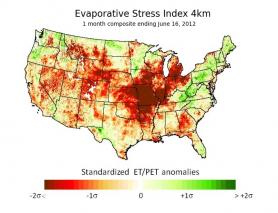Drought early warning information increases mitigation options
In the growing season, farmers and ranchers keep a watchful eye for any sign of drought. Early warning information can increase the range of options for mitigation, and the time available to select them.
Hit hard by drought
Barbara and George Cooksley, owners of the Cooksley Ranch in the Sand Hills of Nebraska, know firsthand the benefits of good land stewardship. Having the right number of cattle on their land to maximize their profit without damaging the native grasses is critical for the long-term viability of their ranch. The optimal size of their herd changes from year to year, though, as an array of weather and climate events can affect the best balance between cattle and grasses on the ranch. One event that can change the balance point very quickly is drought.
In 2012, the “flash drought” that affected a large swath of the Central Great Plains impacted Cooksley Ranch. Exceptional drought conditions (the highest category designated by the U.S. Drought Monitor) developed very rapidly, necessitating a series of quick decisions on the ranch.
As the signals of drought began to appear during the first part of the 2012 growing season, the Cooksleys decided to keep their yearling calves and replacement heifers off pasture. They hoped this would give the native grasses more time to grow prior to the summer grazing season. By early June, as they recognized signs of the drought continuing, they decided to sell part of their herd. This was the best way to reduce the amount of grass they would need for summer grazing. They also made agreements with area farmers to bale crop residue for additional feed; this would replace the hay from native grasses that did not grow during the drought.
Drought early warning

The Evaporative Stress Index (ESI) describes temporal anomalies in evapotranspiration (ET), highlighting areas with anomalously high or low rates of water use across the land surface.
Climate scientists already produce seasonal climate and drought outlooks that can provide guidance for ranchers’ yearly plans. Over shorter time scales, however, detecting the onset of flash drought requires frequent updates of datasets that can show a drying trend before vegetation becomes visibly stressed. A promising approach in this realm is to use satellite-derived drought indicators, such as the Evaporative Stress Index (ESI). This innovative drought index depicts changes in the amount of water vapor released by vegetation via transpiration. As decreases in soil moisture in the root zone can reduce the amount of water released through transpiration, and this decrease often precedes a visible decline in vegetation health and greenness, monitoring the ESI could provide early warning of developing drought.
More options for mitigation
With an ESI-based early warning system, the Cooksleys and other ranchers could take proactive measures to lessen their exposure to drought. For instance, if the ESI indicates that the risk of drought development is above average for the next month or two, ranchers might obtain additional feed, relocate livestock, or reduce the size of their herd before they face a decline in available feed.
After dealing with the effects of rapid-onset drought, the Cooksleys are eager for a system that can provide early warning of drought. The more time they have to make decisions to mitigate the effects of drought, the more resilient they can be.
References
- Otkin, J.A., M.C. Anderson, C. Hain, I. Mladenova, J. Basara, and M. Svoboda, 2013: Examining Rapid Onset Drought Development Using the Thermal Infrared-Based Evaporative Stress Index. J. Hydrometeor., 14, 1057–1074, doi:10.1175/JHM-D-12-0144.1.
- Otkin, J.A., M.C. Anderson, C. Hain, and M. Svoboda, 2014: Examining the Relationship between Drought Development and Rapid Changes in the Evaporative Stress Index. J. Hydrometeor., 15, 938–956, doi:10.1175/JHM-D-13-0110.1.
Story Credit: Jason Otkin, University of Wisconsin-Madison Space Science and Engineering Center. Gene Daniels, Photographer. NARA record: 8463941. U.S. National Archives and Records Administration, public domain, via Wikimedia Commons.
Note: This story is reprinted with permission: http://toolkit.climate.gov/taking-action/drought-early-warning-information-increases-mitigation-options
